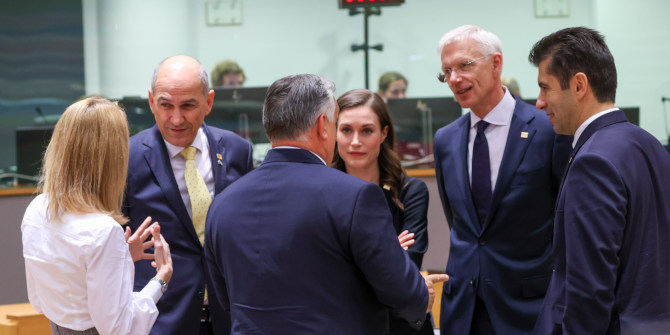The EU’s institutions have a relatively high level of personnel turnover. If previous trends continue, for instance, up to a third of the ministers who participate in the Council of the EU this month will have moved out of their positions within a year. Drawing on a new edited volume, John A. Scherpereel examines the impact this personnel carousel has on the EU’s legitimacy.
Each January, EU watchers tend to follow the lead of the first month’s namesake, Janus, the famously two-faced ancient Roman god. Like Janus, they look backward and forward in time, imposing meaning on past events, forecasting where the Union might be headed.
In their Janus-faced reflections, observers frequently consider the comings and goings of political leaders. This January, for example, they are debating whether Angela Merkel’s replacement by Olaf Scholz might affect Europe’s strategic direction. They are wondering whether the results of 2022’s elections (e.g., in France and Hungary) might lead Europe to bolster its pursuit of ‘strategic autonomy’ and/or decelerate the trend of autocratisation.
These kinds of musings reflect an intuition that personnel turnover matters – that the coming and going of incumbents has important effects on politics. In a recently published volume, my collaborators and I investigate this intuition. We are particularly interested in the ways that turnover trends affect EU legitimacy.
Turnover is a critical feature of all political systems. However, we find that the amount of turnover in the EU’s institutions can be particularly high. This is especially true at the top levels of the Union’s more intergovernmental institutions. If past trends hold, for example, over a third of the ministers who participate in the Council of the EU this month will have moved out of their positions by the same month next year.
Chief executives’ seats are also quite hot: historically, over a fifth of the members of the European Council have vacated their positions over the course of a twelve-month period. The EU’s predominantly supranational institutions are generally less volatile, with quantities of annual turnover ranging from 11.7% (the Court of Justice) to 15.9% (the Commission).
Within institutions, turnover trends vary across a number of qualities. In the Council system, for example, quantities of turnover tend not to vary much from one configuration (e.g., Economic and Financial Affairs – ECOFIN) to the next (e.g., Education, Youth, Culture and Sport – EYCS). But important discrepancies lurk beneath this superficial similarity. Men, for example, tend to serve longer than women in ‘harder’ configurations like ECOFIN, while women tend to serve longer than men in ‘softer’ configurations like EYCS.
The European Parliament’s average annual turnover, to take another example, is 12.9% – not dramatically higher than the amount of turnover in many national legislatures. Across national MEP delegations, though, differences are clear. Since 1979, for example, almost 19% of French MEPs who are sworn in at the beginning of a five-year session have vacated their seats by the end of the session. The equivalent number for German MEPs is 7.3%.
Different sets of politically engaged Europeans may be encouraged by the fact that the EU’s personnel carousel spins quite rapidly. Despite the many points of contention between them, for example, both right-wing populists (for whom the replacement of out-of-touch elites with grounded challengers may help to redeem a decadent EU) and feminists (who criticise the resilience of gender hierarchies embedded in incumbents’ practices) may be encouraged by the opportunities that fast-moving personnel carousels present.
Certain strains of research also point to turnover’s salutary effects, suggesting, for example, that turnover can help to legitimise democratic politics and to discourage what one observer has called the ‘three As’ – arrogance, apathy, and atrophy – from setting in among incumbents. But alternative theoretical considerations suggest that turnover may, in fact, undermine legitimacy.
When large numbers of incumbents voluntarily resign their seats, they may be signalling to broader publics, effectively telling them that the system and its institutions are not worth much. Turnover may also raise the odds that knowledgeable professionals will be replaced by amateurs. And the adjustments that newcomers must make when entering a complex system may involve a big time cost – increasing the time it takes to reach decisions and decreasing people’s faith in the system’s ability to address their concerns.
The results of elections and government changes that take place in 2022 are… likely to affect the EU’s future. But the personnel churn that characterises the broader EU system will, too.
To assess the various predictions that come out of contemporary debates and theoretical treatments, we examine the effects of turnover on three frequently discussed facets of legitimacy – input, throughput, and output. In general, we find that turnover has few effects on the EU’s input legitimacy – on the extent to which citizens, through both attitudes and behaviours, support the EU system.
In the first years of the modern (post-1979) era, citizens from member-states whose MEPs treated the European Parliament as a ‘disposable institution’ (e.g., as a way station that should be abandoned as soon as a more attractive domestic position was found) were more likely to discount the European Parliament themselves. This effect, though, has dissipated with time. And turnover among MEPs does not seem to affect turnout in European Parliament elections.
But turnover’s effects on throughput legitimacy – the system’s processing capacity/quality – and output legitimacy – the system’s ability to solve problems and address public concerns – are significant. As turnover in the Commission and the Council rise, for example, the EU’s ordinary legislative procedure slows down. When more women ministers hold onto positions at the heights of the Council system, the legislative process works better. And not all ‘amateurs’ perform less well than their tenured colleagues. Yes, MEPs that lack institutional experience at the national or subnational level tend to struggle. But newcomers that come to Brussels with ‘sub-EU’ institutional experience generally perform quite well.
When it comes to output legitimacy, we focus on the interface between EU institutions and actors, on one hand, and international interlocutors, on the other. In the Brexit negotiations, for example, the personnel continuity on the EU side – where Michel Barnier headed a stable team from start to finish – contrasted markedly with the volatility of the UK side – where ministers and top officials came and went with great frequency. This imbalance generated significant leverage for the EU side.
In at least one Western Balkan case (Bosnia), though, the ‘turnover imbalance’ has been inverted. There, entrenched domestic elites have successively outmanoeuvred a rotating cast of EU special envoys and diplomats, who have themselves had to interface with a changing set of EU member governments with fluid preferences. Whether in exit politics or the enlargement realm, then, the high-turnover side has struggled.
In sum, the results of elections and government changes that take place in 2022 are, indeed, likely to affect the EU’s future. But the personnel churn that characterises the broader EU system will, too. The spinning personnel carousel – whose rotation often seems as unremarkable and invisible as the rotation of the Earth itself – will continue to affect the ways the EU works and the outputs the EU system manages to produce.
For more information, see the author’s new edited volume, Personnel Turnover and the Legitimacy of the EU (Palgrave Macmillan, 2021)
Note: This article gives the views of the author, not the position of EUROPP – European Politics and Policy or the London School of Economics. Featured image credit: European Council




